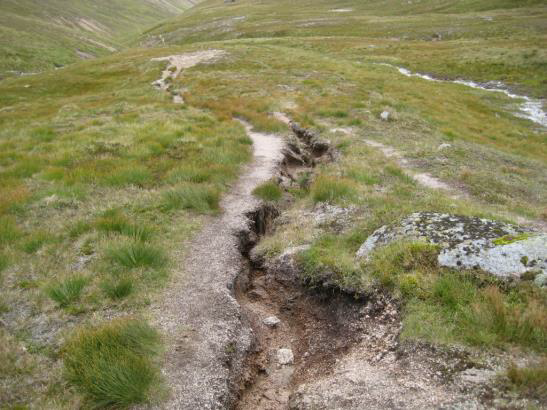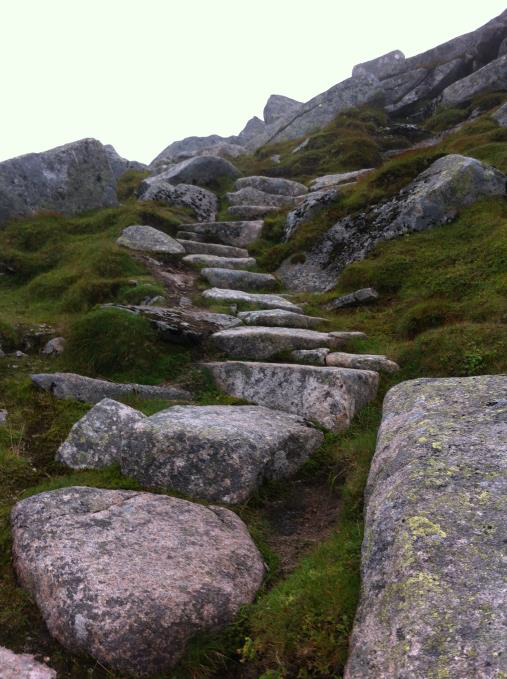
Ross Mackay & Katrin Prager
(Savills, Perth and Dept of Geography, University of Aberdeen)
This is a much-abridged version of an article that appeared in the Scottish Geographical Journal, Vol. 137 (2021), pp. 131-157.
Much recreational use of the Scottish mountains depends on footpaths, of which there are at least 1100 km across upland Scotland, mostly over private land.
 |
| Path erosion © the authors |
In the Scottish context, understanding what motivates private landowners to engage in upland path management may aid the design of appropriate incentives, through public policy or otherwise, that support investment in these footpaths. Research into the general motivations of private estate owners in Scotland has shown that, for most, economic factors dominate. While many express socially and environmentally conscious sentiments, perhaps linked to the privilege of land ownership and wealth, these motivations may be suppressed in management decisions due to financial constraints.
A study conducted in summer 2020 within the Cairngorms National Park investigated land manager motivations and behaviours, and their actual engagement in managing upland paths, on 11 privately owned estates with one or more Munros. Two other holdings, one charity-owned and one publicly owned, were also included to provide contrast, and three informants with professional links to footpath management.
Participants expressed a general awareness of the damage potential of recreation in the uplands, even amongst those who felt this was not currently an issue on their land. Awareness was higher on properties where access utilisation is high, and many of the potential impacts were realised. An aesthetic factor was most frequently mentioned, and the motivation to act was linked to preventing the path becoming an ‘eyesore’ in the landscape. There was almost no consideration given to pre-empting damage, only reacting to it when it had begun to become a big issue. Land managers who prioritised conservation objectives understood the damage of erosion, trampling and disturbance. However, there appeared to be less understanding of ecological impacts such as on species composition. Footpath management was unanimously accepted as a reasonable and effective mitigation for the damage caused by access takers.
Only a few of the private land managers prioritised conservation; most had diverse objectives framed by economic considerations, and a more reserved approach to public access facilitation. All noted potential conflicts between public access and other management objectives. Such ‘difficulties’ include disturbance of wildlife resulting in welfare and distribution concerns, vegetation damage and erosion by trampling, and disturbance to deer management activities. For some owners, public access can also compromise their privacy and amenity enjoyment of their property.
Both non-private and private land managers agreed that reducing the human impacts of erosion and ecological damage should be the primary motivation to undertake upland footpath works.
 |
| New Path, Lairig an Laoigh © the authors |
The social context in which intention is formed to undertake footpath management was influenced by land managers’ perceptions of the expectations of their peers and of the public. All participants reported low to non-existent direct pressure from access users, even where path conditions were less than ideal. Nevertheless, most felt that public perception of private land ownership is an important factor. No peer pressure was evident among the participants, who seemed to understand that each property has its own unique objectives and financial limitations. However, among those for whom public access is considered a nuisance, peer pressure may act to dissuade engagement in footpath management.
All private land managers were engaging in, or willing to engage in, footpath management to a certain extent, in order to deliver a public good in the context of more general discourses on land reform and sustainable use.
Most upland path management in Scotland is funded by charitable and voluntary donations, and some from car-parking charges. The Outdoor Access Trust for Scotland (OATS) presides over nationwide rebuild, repair and upgrade schemes, the latest being the £5.6M ‘The Mountains and The People’, 2015-2020. The National Trust for Scotland and John Muir Trust have their own path budgets and campaigns.
 |
| Excellent co-funded path repair on Lochnagar ©C
Lacy |
The presence or absence of funding was the key influence on intention and behaviour regarding upland footpath management, to the extent that intention could be overruled, and other behavioural controls became almost irrelevant. If all else in relation to a project looked favourable, funding had absolute power over its fate. Visitor car park charges were deployed – with high compliance – by 6 of 11 properties, and can generate modest sums. The remaining 5 private estates perceived parking charges as too politically charged to attempt.
Some private landowners may be reluctant to seek grant funding, even once they had noticed the first signs of damage, erosion and path-widening, due to the loss of management autonomy, and perhaps raising the route’s profile. The single instance of privately funded capital work encountered in the study concerned paths in a particularly sensitive habitat, where the estate chose to avoid grant funding.
With climate change bringing summer downpours, rapid snowmelt and strong winds, upland paths are likely to require more maintenance. However, snow and strong winds limit the times that works can be carried out. A further barrier is the availability of contractors; despite efforts to grow this specialist work force, it tends to leave the industry once funding for large path work projects finishes. Where routes pass through an area with some form of conservation designation, the planning process may become more arduous, requiring NatureScot consent for most works. Reliance on helicopters to bring stone and equipment to the worksite may bring seasonal restrictions near raptor nests, thus reducing the work season further.
It was unanimous that funding of footpath management was the principal barrier to enacting positive intention, and, where this could be addressed, all other potential barriers such as weather and contractor availability could be overcome. Even where intention was low, access to funding appeared to be a sufficient catalyst to trigger the intended behaviour. Conversely, the absence of funding usually resulted in non-action, irrespective of the strength of intention.
Landscape-scale erosion damage is often the trigger point for action over upland path management. There is less awareness of issues such as faunal and floral disturbance. Public bodies could take the lead in raising awareness of off-path impacts, which may lead to earlier identification of damage and disturbance, and therefore to earlier intervention.
Current support is insufficient in both availability and accessibility. Although most public access is taken over private land, its managers experience barriers to accessing funding. To encourage further participation, funding models should take into account the resources available to those with whom they need to engage.
The availability of funding was identified as the key behavioural control. The motivation for path upkeep is present and even high in some land managers due to awareness of damage, conservation objectives, and recognised benefits to the property and the landowner’s reputation in society. The heavy current reliance on charitable funding works in favour of non-private landowners, while presenting a significant challenge for private landowners.
Public intervention needs to ensure that ongoing maintenance of footpaths
is covered, in addition to capital investment in building projects. A
model similar to the forestry grant system, with capital and recurrent
maintenance payments, should be explored.
Please let the webmaster know if there are problems with viewing these pages or with the links they contain.